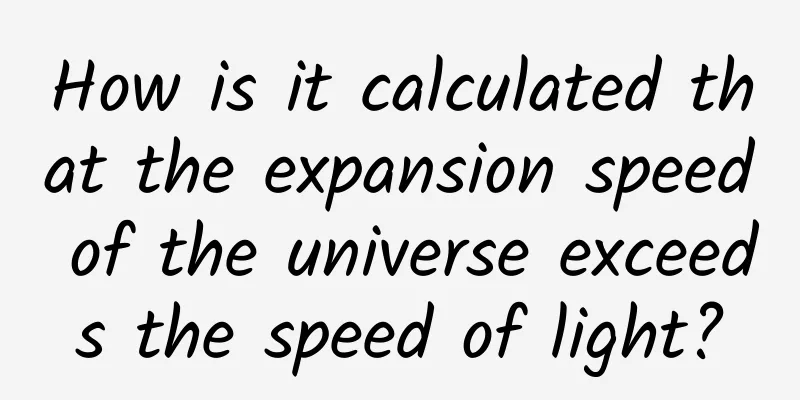How is it calculated that the expansion speed of the universe exceeds the speed of light?

|
Einstein's special theory of relativity draws a red line for the speed of light, which means that the speed of light is the fastest in the universe and is the ceiling. All material movements must not break through this ceiling. However, in the standard model of the universe, the expansion of the universe exceeds the speed of light. In this way, many netizens are very confused. Since the movement of matter cannot exceed the speed of light, why can the expansion of the universe be possible? There are many such questions on the Internet, see the screenshot below: These questions are similar, that is, they cannot make clear the difference between the expansion of the universe faster than the speed of light and the movement of objects at the speed of light, and the latter question itself seems to have given the answer. Simply put, the speed of light barrier requires that objects with rest mass cannot exceed the speed of light, while the expansion of the universe is the expansion of space-time. Space-time itself has no mass and is of course not limited by the speed of light. I have answered this type of question many times in the past. Seeing that many friends on the Internet still don’t understand it, I will briefly and systematically explain it again. If you can read it patiently, I believe you will fully understand it. If you still have questions, please leave a message in the comment section below and I will try my best to answer them. But one thing needs to be explained: all my answers are based on scientific common sense recognized by the modern scientific community, such as the standard model of cosmology. The so-called standard model of cosmology is a model based on Einstein's general theory of relativity that describes the laws of motion of a uniform and identical universe. If someone refuses to acknowledge scientific common sense (that is, the consensus of the scientific community) and insists on arguing with you, I will not entertain him/her. What is the expansion of the universe? The so-called cosmic expansion refers to the continuous expansion of the entire universe on a large scale. It was first discovered and proved by the famous American astronomer Edwin Hubble. In order to commemorate him, the first top space telescope was named after him. After the Hubble Space Telescope was launched, it greatly broadened the horizons of mankind and gave us a subversive understanding of the universe. Hubble came to the conclusion of the expansion of the universe in 1929 based on long-term observations. This conclusion holds that the entire universe is constantly expanding and is uniform, and all galaxies are evenly separating from each other, getting farther and farther away from each other. From the observation of the earth, all directions are the same, which is called isotropy; the farther the galaxy is from us, the faster it will recede, and the recession speed is proportional to the distance. From this, he derived Hubble's law, which can be simply expressed as: V=HD. Here V represents the recession velocity of the galaxy; H represents the Hubble constant, which is defined as the recession velocity of the galaxy at a distance of 10Mpc from us, in units of s/km (seconds/kilometer); D represents the actual distance of the galaxy from us. Mpc is a million parsecs, and 1pc (parsec) is about 3.26 light years. This observation result is completely consistent with Einstein's general relativity theory, resolving the contradiction between Einstein's field theory and the absolute view of space and time, thus adding crucial evidence to the Big Bang universe model, indicating that the universe has never stopped expanding since the explosion of the singularity. To use a vivid metaphor, the current universe is like an inflating balloon. This balloon is the expansion of the singularity, and all galactic matter is the star-like patterns on the balloon membrane. As the balloon continues to expand, these star-like patterns are moving away from each other. Looking around from any point on the balloon's surface, everything looks the same, so the universe has no center. The membrane of the balloon is the universe (or space-time), which has no mass, while the star-studded pattern is the galaxies inlaid in the universe, which have mass. These massive galaxies themselves do not move, just like people sitting on a train. The train is running, but the people on the train are not running. You can also imagine it as baking bread. The bread itself is space-time. The bread is expanding, and the raisins embedded inside are also pulled apart from each other. But the raisins do not move. They just get further apart from each other as the bread expands. As the universe expands, galaxies that were once crowded together become increasingly separated from each other, and appear to be moving away from each other. However, the expansion of the universe is only the expansion of space-time, not the movement of objects with mass, and therefore is not constrained by the speed of light. How is the rate of expansion of the universe calculated? The calculation of the expansion rate of the universe is based on Hubble's law. As mentioned earlier, there are several algebras in Hubble's law, V represents the total speed, H represents the Hubble constant, and D represents the actual distance. According to this formula, we must first know the Hubble constant before we can substitute the data for calculation. In order to obtain an accurate Hubble constant, many astronomers have tried every possible means to carry out a large number of measurements over the past few decades, and obtained several representative data: In 2006, the Marshall Space Flight Center used the Chandra X-ray Telescope to obtain a result of 77km/s, with an error of about 15%; in 2009, NASA (National Aeronautics and Space Administration) obtained a result of 74.2±3.6km/s based on measurements of the la supernova; in 2013, the European Space Agency obtained a result of 67.8±0.77km/s based on measurements of the Planck satellite; in 2019, German scientists used the gravitational lens effect to obtain a result of 82.4km/s. The data measured by each method are not completely consistent, and there are even large differences. The age and expansion rate of the universe calculated by different data are different. Today we compromise these data and get an average value of: (67.8+77+74.2+82.4)/4=75.35km. That is to say, at a distance of 3.26 million light years from us, the speed at which the galaxy is moving away from us is about 75.35 km/s. Based on this compromise Hubble constant, we can measure the rate of expansion of the universe. According to the principle of isotropy, the farther the faster, and the relationship between the distance and the recession speed, we can calculate the recession speed of galaxies at any distance relative to us. For example, at a place 3.26 million light years away, the speed is 75.35 km/s; at a place 100 million light years away, the speed is 2311.35 km/s. The radius of our observable universe is 46.5 billion light years, which means that the galaxy farthest from us is moving away from us or retreating at a speed of 1074777.75 km/s. This speed is about 3.58 times the speed of light, which is why the expansion speed of the universe is greater than the speed of light. Since the expansion of the universe is several times faster than the speed of light, why can't we feel it? This is because the so-called expansion of the universe is greater than the speed of light, which is the superposition speed of the expansion of the entire universe. Figuratively speaking, it is the total expansion speed of the entire cosmic balloon. It is the speed at which we and the farthest galaxy in the observable universe are moving away from each other, not the speed at which galaxies are separating from each other at close range. This is a law of the universe on a large scale as a whole and cannot be applied to nearby celestial bodies. I once used inserting bamboo poles to illustrate this effect. If we insert 1,000 bamboo poles, with each pole 1 kilometer apart, and we simultaneously pull each bamboo pole 1 meter apart, the bamboo pole closest to us at a distance of 1 kilometer will be 1 meter away from us, which is visually difficult to feel; but the bamboo pole that is 1,000 kilometers away from us is instantly pulled 1,000 meters away from us, and the speed increase effect is very obvious. When they reach the position of 300 million bamboo poles, all the bamboo poles move 1 meter in 1 second (uniform expansion). At the position of the 300 millionth bamboo pole, the distance from the observer (such as the earth) is increased by 300 million meters per second, which reaches the speed of light. This shows that the expansion of the universe is only a large-scale expansion. At very close distances, the expansion is very slow and not obvious. Celestial bodies at close range are mainly bound by gravity, such as the solar system and even the Milky Way, which are held together by gravity, and the influence of the expansion of the universe is difficult to sense. Even the Andromeda Galaxy, which is 2.54 million light-years away from us, is still getting closer due to the huge gravitational force between it and the Milky Way. It is predicted that the two galaxies will collide and merge in 3 to 4 billion years. But overall scientific observations have proven that distant galaxies are moving away from us, and the most obvious evidence is the redshift phenomenon. This is the Doppler effect of light waves. Everything that propagates in the form of waves has the Doppler effect, such as sound waves. When a car or train approaches us at high speed, the sound is higher than when it is not moving; and when it is moving away, the sound is lower than when it is not moving. The Doppler effect of light waves is that the spectrum of an object approaching at high speed will move toward the blue end, referred to as blueshift; the spectrum of an object moving away at high speed will move toward the red end, referred to as redshift. Scientists observe distant galaxies and see redshifts. The amount of redshift is proportional to the distance, so the speed at which a galaxy is moving away from us can be determined by the amount of redshift. According to Hubble's law, the speed at which a galaxy is moving away from us can be used to deduce its distance from us. Scientists have observed that the spectrum of the Andromeda Galaxy has shifted blue, proving that it is moving closer to us. At this point, we should understand that the superluminal expansion of the universe is just the superluminal speed of the entire space, while the expansion speed of each local area is very slow, and some are even affected by gravity and move closer to each other. Therefore, the superluminal expansion of the universe is completely different from Einstein's theory that the speed of light limit cannot be exceeded. This is the basics of the expansion of the universe. Welcome to discuss. Thanks for reading. The copyright of Space-Time Communication is original. Infringement and plagiarism are unethical behavior. Please understand and cooperate. |
<<: Milk and yogurt are both nutritious, but they may not be what you think...
Recommend
Wang Nan will help you build your account for 21 days + 21 days of running course video
Wang Nan’s 21 Days to Help You Create an Account ...
Poor traffic conversion recently? Share 8 high conversion techniques!
If you were asked to choose between the following...
OS X 10.11 will have a control center, iOS 9 will support older A5 devices
It is reported that Apple introduced the control ...
Falcon wing shape is not enough Tesla Model X "back" ski rack
Recently, according to the website electrek, the ...
Can Samsung TV, which is determined not to produce OLED, still gain a foothold in the future TV market?
If the industry's most important mobile phone...
Tmall agency operation: What is the specific process for making a single product a hit?
The general process of implementing a single prod...
16 excellent open source WeChat mini program projects, a great tool for taking orders and making money!
For domestic Internet ToC applications, WeChat Mi...
U.S. senators call for U.S. to reject Oracle's deal with TikTok
[[342139]] This article is reproduced from Leipho...
5 major scenes and 11 camera techniques for short video shooting
Why do short videos shot by others get millions o...
Advanced event planning: 4 steps to control event costs
An activity is generally divided into four parts ...
How much does it cost to join a restaurant kitchen app in Jixi?
For entrepreneurs, although mini program developm...
Wuwei teacher Li Dong's "Bull Stock Special Training Camp" from a novice to a stock picking expert
3 seconds to see through the main force's int...
I have seen 1,000 marketing promotion cases, why are they all ineffective?
In the circle of friends and subscription list of...
Analysis of Perfect Diary: How should the beauty industry conduct online marketing?
In the Internet age, consumers are no longer so k...
One trillion times brighter than the sun, this large scientific device will emit its first beam of light by the end of the year
The high-energy synchrotron radiation source of t...









